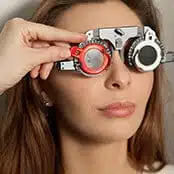
Age-related macular degeneration (AMD) impacts the sight of millions of senior Americans. Wet AMD is more serious, causing sudden vision loss. Early detection at your eye center in St. Louis is key to preserving sight. Learn here how ophthalmologists diagnose wet age-related AMD and how treatment offers real hope.
Your Wonderful Retina
Its location of the macula, the circular and highly vascularized structure, responsible for visual acuity, light perception (night vision), and peripheral (side) vision. Over time, the macula deteriorates. With dry macular degeneration, small, hard deposits form, skewing the sharpness of your vision.
Of greater concern is wet macular degeneration, in which the many blood vessels in the retina at the back of the eye multiply out of proportion. This extra vascularization actually grows under the macula, causing it to bulge suddenly. Central vision degrades quickly, but peripheral vision generally remains intact.
Causes of AMD continue to baffle researchers. Age, obesity, heredity, light eye color, and smoking appear to factor into its development. Fortunately, ophthalmologists accurately diagnose and treat this eye condition. The following are some of the newest and most effective diagnostics your ophthalmologists in St. Louis, MO, use to discover wet age-related macular degeneration.
Diagnosing Wet AMD
As part of a comprehensive examination at your eye center in St. Louis, your board-certified ophthalmologist will examine the back of your eye (retina). This procedure is painless and involves instilling of special drops and viewing the retina with a bright light. A mottled retinal appearance indicates dry AMD. Also, the eye doctor will have you look at an Ansler grid. A person with AMD will see the lines in the grid as crooked or wavy.
When the doctor suspects wet AMD, or wishes to monitor its progression, they inject a special dye into a vein in the arm. This dye helps the doctor see the small vessels in the retina clearly, and if any extra growth or bulging is present. This procedure, called fluorescein angiography, is comfortable and yields real-time images of various parts of the retina.
Another advanced diagnostic procedure is indocyanine angiography. This test allows the eye doctor to visualize problems with vessels deep down in the retina, similar to fluorescein.
Finally, optical coherence tomography (OCT) monitors the progression of already diagnosed wet age-related macular degeneration. The results of this test yield important findings such as thickness, thinness, and other structural abnormalities of the retina as they develop. OCT is non-invasive and shows cross-sections of the retina in vivid detail.
Preserving Your Vision
While age-related macular degeneration in all its forms may not be avoidable, there are prevention and treatment strategies you can employ at home to diminish the impact of AMD, including:
- Always wear sunglasses outdoors and in very bright indoor light situations
- Getting a yearly eye exam after age 40 to detect eye changes as early as possible
- Taking zinc, copper, beta-carotene, and other vitamin and mineral supplements as advised by your eye care provider in St. Louis
- Stopping all tobacco usage
- Checking your vision weekly with an Ansler grid to detect wavy or crooked lines
- Eating a healthy diet high in lean protein, low-fat dairy, and dark greens, such as spinach and kale
- Controlling blood pressure and blood glucose levels
Get Superior Eye Care in St. Louis, MO, Area
At Advanced Sight Center, Dr. Howard Short and Dr. R. Joseph Olk are our board-certified ophthalmologists. They are experts in the acute and chronic conditions of the eye, continually bringing the most up-to-date diagnostic and treatment techniques to patients of all ages. We also have an on-site optical boutique for your contacts, eyeglasses, sunglasses, and more.
We invite you to call today for an eye exam appointment in Washington, MO. Our phone number is (636) 239-1650, or fill out an appointment request form.



